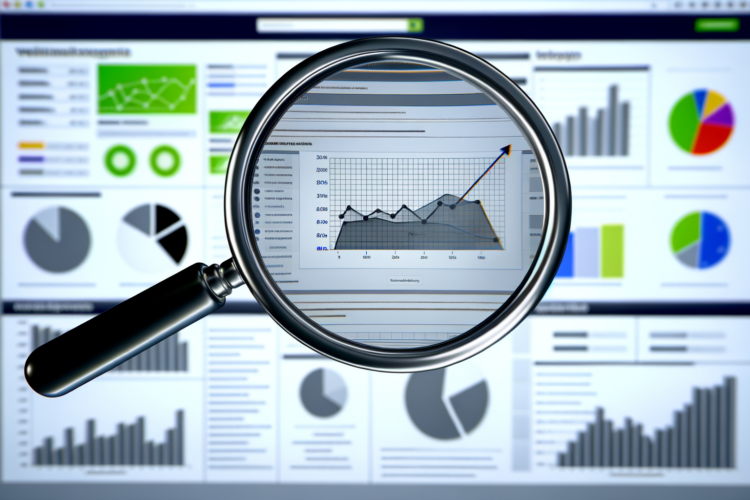
Forecasting SEO potential with Google Data Studio involves utilizing its customizable dashboards and data visualization to monitor key SEO metrics, set benchmarks, and predict future performance trends based on historical data. By integrating Google Analytics, Search Console, and other data sources, you can create reports that not only reflect current standings but also allow you to project future growth by analyzing patterns, seasonality, and other contributing factors.
Understanding the Basics: What is Google Data Studio?
Google Data Studio is a powerful tool for creating data dashboards and reports that are easy to read, easy to share, and fully customizable. It’s a part of the Google Marketing Platform and serves as a free data visualization tool that can convert raw data into informative, easily understandable reports. With its dynamic nature, you pull in data from various sources, such as Google Analytics, Google Ads, Search Console, and even non-Google databases like MySQL or Excel files.
Getting Started: Setting Up Your First Data Studio SEO Report
Before diving into predictions, you must set the stage by setting up a report that accurately reflects your SEO efforts. Here are the preliminary steps:
Step 1: Connect Your Data Sources
After signing into Google Data Studio, create a new report and add your data sources. For SEO, it’s common to begin with Google Analytics and Search Console. To connect, select ‘Create New Data Source’ and authorize the desired platform. Once connected, add the sources to the report.
Step 2: Familiarize Yourself with Your Data
Take time to understand the data metrics and dimensions you can work with. For SEO, look at organic traffic, bounce rates, session durations, goal completions, and keyword rankings. Knowing what each metric represents will be critical in forecasting.
Step 3: Lay Out Your Report
Now, start laying out your report. Drag and drop charts and graphs, and choose which dimensions and metrics to display. It’s a good practice to set up different pages for different data sets — such as one page for traffic trends and another for keyword performance.
Digging Deeper: Analyzing Historical Data to Forecast SEO Potential
Once you’ve set up your reports, the next step is using this historical data to forecast SEO potential.
Identifying Patterns and Trends
Look at historical data over a significant period, typically 12 months or more, to identify any trends or repeatable patterns. Pay attention to:
- Traffic Increases/Decreases
- Seasonal Fluctuations
- Performance of New Content
- Google Algorithm Updates
Utilizing Time Series and Regression Analysis
For a more quantitative approach, use time series analysis to spot trends and forecast future values based on past performance data. Regression analysis can further help predict the relationship between organic traffic and other variables, such as backlinks acquired or pages published.
Setting Benchmarks and Goals
It’s important to establish benchmarks based on your historical data. This will not only help you measure future success but also create realistic SEO goals.
Creating Customized Forecasting Models in Data Studio
With a keen understanding of past trends, you can now create customized forecasting models directly within your SEO reports.
Step 1: Creating Calculated Fields
Google Data Studio allows you to create calculated fields, which can be used to apply formulas to your existing data. This might be as simple as calculating the average monthly growth rate or as complex as creating a predictive model incorporating multiple variables.
Step 2: Using Data Studio’s Advanced Functions
Make use of Data Studio’s advanced functions, such as the FORECAST function which can estimate future values based on the linear trend of the data points.
Step 3: Fine-Tuning Your Model
Adjust your model based on outliers or anomalies in your data that may skew results. Play with different scenarios, factoring in potential SEO campaigns, additional content strategies, or changes in Google’s algorithm.
Visualizing SEO Forecasts: Charts and Graphs that Convey Your Predictions
SEO forecasts must be visual to make an impact. Several types of visualizations help convey SEO predictions effectively:
Line and Combo Charts
Line charts are great for showing trends over time, and combo charts can show your actual data versus your forecasted data in a clear manner.
Bar Graphs
Bar graphs can show comparisons, such as expected traffic growth month over month or year over year.
Scatter Plots
Scatter plots may be used to visualize the correlation between different metrics that could affect your SEO results, such as page load times vs. organic traffic trends.
Testing and Refining Your Forecasts
Your SEO forecasts will not be set in stone. It’s important to continually revisit and refine your predictions. Regularly compare your forecasts to actual performance, and adjust your models accordingly.
Continuously Update with New Data
As new data comes in, update your reports. This not only refreshes your forecast but may validate or challenge your previous assumptions.
Apply Learnings to Fine-Tune Strategies
Use the discrepancies between forecasts and actuals to understand where your SEO efforts may be falling short or exceeding expectations.
Finishing Thoughts
Forecasting SEO potential with Google Data Studio is an ongoing process of understanding historical data, recognizing patterns, creating predictive models, and visualizing future performance. It is a powerful way to set realistic goals and measure the impact of your SEO strategies. By continuously monitoring your predictions against real-world results, you can significantly improve the accuracy of your forecasts and the effectiveness of your SEO initiatives. Whether you’re an SEO specialist or a business owner, weaving this forecasting approach into your regular reporting can be a game-changer for your online visibility and success.
Frequently Asked Questions
What is Google Data Studio and how can it be used in SEO?
Google Data Studio is a free tool that allows users to visualize data from various sources, such as Google Analytics, Google Search Console, and other third-party data. In SEO, it can be used to create custom reports and dashboards that show an overview of your website’s performance in search results, including traffic, rankings, and other important metrics.
How can I connect Google Data Studio to SEO-related data?
You can connect Data Studio to your SEO-related data by utilizing built-in connectors for services like Google Analytics and Google Search Console. You can also use community connectors or even build your own to pull in data from other SEO tools and platforms. Once connected, you can easily import your SEO data into Data Studio for analysis and reporting.
What kind of metrics should I include in my SEO forecast reports?
In your SEO forecast reports, you should include metrics that can indicate potential for growth and provide actionable insights. Common metrics to consider are organic traffic, keyword rankings, click-through rates (CTR), bounce rates, conversion rates, and backlinks. It is also helpful to track year-over-year trends and compare performance to previous periods.
Can I predict organic traffic growth with Google Data Studio?
Google Data Studio itself does not provide predictive analysis out-of-the-box. However, you can use your historical data within Data Studio to create linear or polynomial trend lines that help estimate future traffic trends. For more advanced forecasting, you may need to use additional statistical tools or Google Sheets to conduct a regression analysis and then import the results back into Data Studio.
What is the best way to visualize SEO performance over time?
The best way to visualize SEO performance over time is through line charts or area charts that track metrics such as organic traffic, keyword positions, and CTR over different timeframes. This can help you identify trends and seasonality in your data. Including comparison periods, like month-over-month or year-over-year, can also provide valuable context for assessing performance.
Can I use Google Data Studio for keyword research and analysis?
Yes, Google Data Studio can be used for keyword research and analysis by importing data from Google Search Console or other keyword research tools. By creating a dashboard that displays search terms, their performance metrics, and trends, you can gain insights into which keywords are driving traffic and conversions, and identify new opportunities for optimization.
How do I share my Google Data Studio SEO reports with my team or clients?
You can easily share your Google Data Studio SEO reports with your team or clients by clicking on the “Share” button in the top right corner of your report. From there, you can invite individuals by email to view or edit the report, or you can get a shareable link. You can also set the report to be publicly accessible if needed, or embed the report in a website or intranet page.
Are there any best practices for designing SEO reports in Google Data Studio?
Designing effective SEO reports in Google Data Studio involves a few best practices:
- Focus on clarity: Make sure your reports are visually clear and easy to understand, using labeled charts and tables that accurately represent your data.
- Customize to your audience: Tailor reports to the information needs of your audience, highlighting the most important metrics for them.
- Use color and layout wisely: Utilize a logical layout and color scheme to draw attention to key data points without overwhelming the viewer.
- Make your reports interactive: Take advantage of Data Studio’s interactive features like date range filters and segment dropdowns so users can explore the data on their own terms.
- Incorporate branded elements: Include your or your client’s branding in the report to maintain brand consistency.
What is the importance of forecasting SEO potential?
Forecasting SEO potential is important as it helps you set realistic goals and expectations for organic traffic growth. It can aid in resource allocation, inform your SEO strategy, and assist in demonstrating the value of SEO efforts to stakeholders. By predicting potential SEO outcomes, businesses and agencies can better plan for the future and adjust strategies proactively for the best results.
How frequently should I update my SEO forecasts and reports?
The frequency of updating your SEO forecasts and reports depends on the pace of change in your industry and the scale of your SEO initiatives. For dynamic industries, monthly updates may be beneficial, while in more stable sectors, quarterly updates might suffice. Regardless of the industry, it is important to update forecasts and reports regularly to account for new data and market trends.






